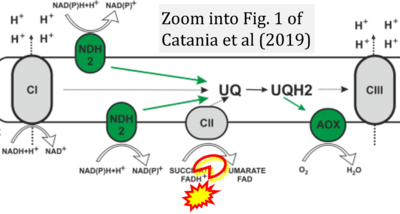Catania 2019 Orphanet J Rare Dis
| Catania A, Iuso A, Bouchereau J, Kremer LS, Paviolo M, Terrile C, Bénit P, Rasmusson AG, Schwarzmayr T, Tiranti V, Rustin P, Rak M, Prokisch H, Schiff M (2019) Arabidopsis thaliana alternative dehydrogenases: a potential therapy for mitochondrial complex I deficiency? Perspectives and pitfalls. Orphanet J Rare Dis 14:236. doi: 10.1186/s13023-019-1185-3 |
Catania A, Iuso A, Bouchereau J, Kremer LS, Paviolo M, Terrile C, Bénit P, Rasmusson AG, Schwarzmayr T, Tiranti V, Rustin P, Rak M, Prokisch H, Schiff M (2019) Orphanet J Rare Dis
Abstract: Background: Complex I (CI or NADH:ubiquinone oxidoreductase) deficiency is the most frequent cause of mitochondrial respiratory chain defect. Successful attempts to rescue CI function by introducing an exogenous NADH dehydrogenase, such as the NDI1 from Saccharomyces cerevisiae (ScNDI1), have been reported although with drawbacks related to competition with CI. In contrast to ScNDI1, which is permanently active in yeast naturally devoid of CI, plant alternative NADH dehydrogenases (NDH-2) support the oxidation of NADH only when the CI is metabolically inactive and conceivably when the concentration of matrix NADH exceeds a certain threshold. We therefore explored the feasibility of CI rescue by NDH-2 from Arabidopsis thaliana (At) in human CI defective fibroblasts.
Results: We showed that, other than ScNDI1, two different NDH-2 (AtNDA2 and AtNDB4) targeted to the mitochondria were able to rescue CI deficiency and decrease oxidative stress as indicated by a normalization of SOD activity in human CI-defective fibroblasts. We further demonstrated that when expressed in human control fibroblasts, AtNDA2 shows an affinity for NADH oxidation similar to that of CI, thus competing with CI for the oxidation of NADH as opposed to our initial hypothesis. This competition reduced the amount of ATP produced per oxygen atom reduced to water by half in control cells.
Conclusions: In conclusion, despite their promising potential to rescue CI defects, due to a possible competition with remaining CI activity, plant NDH-2 should be regarded with caution as potential therapeutic tools for human mitochondrial diseases.
• Bioblast editor: Gnaiger E
Correction: FADH2 and Complex II
- FADH2 is shown as the substrate feeding electrons into Complex II (CII). This is wrong and requires correction - for details see Gnaiger (2024).
- Gnaiger E (2024) Complex II ambiguities ― FADH2 in the electron transfer system. J Biol Chem 300:105470. https://doi.org/10.1016/j.jbc.2023.105470 - »Bioblast link«
Labels:
Enzyme: Complex II;succinate dehydrogenase


